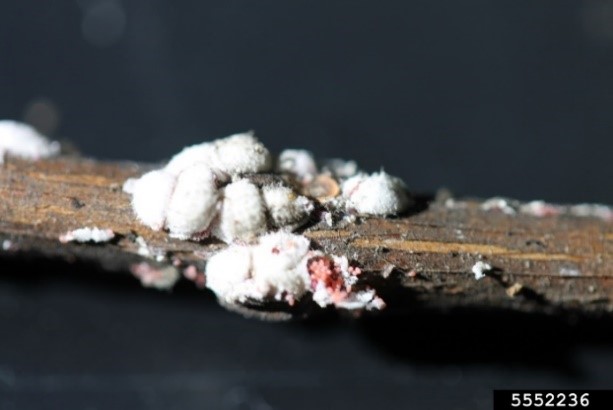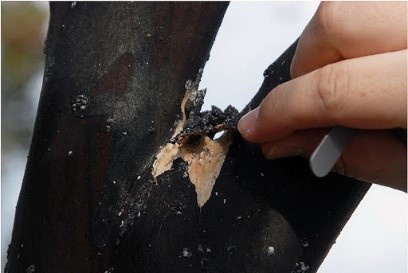Crape Myrtle Insect Pest
OSCEOLA, Ark. – Each year our office receives several calls from homeowners who are seeing black mold (Figure 1), or “white fuzzy growth” on their Crape Myrtle plants. Most often the cause of these symptoms is an insect called Crape Myrtle Bark Scale (CMBS). Adult females appear as white or gray felt-like encrustations on the trunk and branches, and can look like a ‘fuzzy’ growth on the plant (Figure 2.). Many times CMBS will appear near pruning wounds or in branch crotches on older wood.
The crape myrtle bark scale insects feed on the plant’s sap. If the number of insects get large enough, they can cause branch and twig die back. One reason CMBS can develop into large numbers is that they have few natural predators, and they can multiply rapidly.

As they feed, the insect exude a sugary liquid called honeydew. The honeydew promotes the growth of black sooty mold. This will cause the leaves and branches of the Crape Myrtle plant to have a dark to black appearance. It is the black sooty mold that many homeowner first notice on Crape Myrtle plants infested with Crape Myrtle Bark Scale.
Application of systemic insecticides has been shown to provide adequate control of this pest. The best option is to apply insecticide as a soil drench around the root zone after the leaves are out on the plants. Imidacloprid (Merit® or Bayer Advanced™ GardenTree and Shrub Insect Control), thiomethoxam (Meridian®) and dinotefuran (Greenlight Tree and Shrub Insect Control with Safari) have shown best control when applied between May and July.
When drenching the soil with a systemic insecticide, allow several weeks for the product to be distributed throughout the plant. The pesticide will be absorbed by the roots and translocated to the areas of the plant where the scale feed. This treatment will last all season in most cased. Be sure to read the product label and apply the correct amount.
Most labels will call for measuring the circumference of the plant stems, and using the total circumference of all stems for the dose calculations. Measure the stems at about 3 ft height. If the shrub has 6 stems, each with a 5 inch circumference, the total circumference is 30 inches. If the label calls for 1 ounce of insecticide per inch of circumference, use 30 oz total insecticide for your drench. Be sure to wear protective equipment as you mix and apply.
The Extension Service has published a fact sheet for additional details available at the following web address, www.uaex.uada.edu/publications/pdf/fsa-7086.pdf, or at the County Extension Office. Additionally, we have a webpage with more information on crape myrtle bark scale.
For more information, contact the Mississippi County Extension office at 870-563-0236 or email me at rbenson@uada.edu
By Ray Benson
County Extension Agent - Agriculture
The Cooperative Extension Service
U of A System Division of Agriculture
Media Contact: Ray Benson
County Extension Agent - Agriculture
U of A Division of Agriculture
Cooperative Extension Service
3137 West Keiser Avenue Osceola AR 72370
(870) 563-0236
rbenson@uada.edu
Related Links
The Arkansas Cooperative Extension Service is an equal opportunity institution. If
you require a reasonable accommodation to participate or need materials in another
format, please contact your County Extension office (or other appropriate office)
as soon as possible. Dial 711 for Arkansas Relay.
Pursuant to 7 CFR § 15.3, the University of Arkansas System Division of Agriculture
offers all its Extension and Research programs and services (including employment)
without regard to race, color, sex, national origin, religion, age, disability, marital
or veteran status, genetic information, sexual preference, pregnancy or any other
legally protected status, and is an equal opportunity institution.
